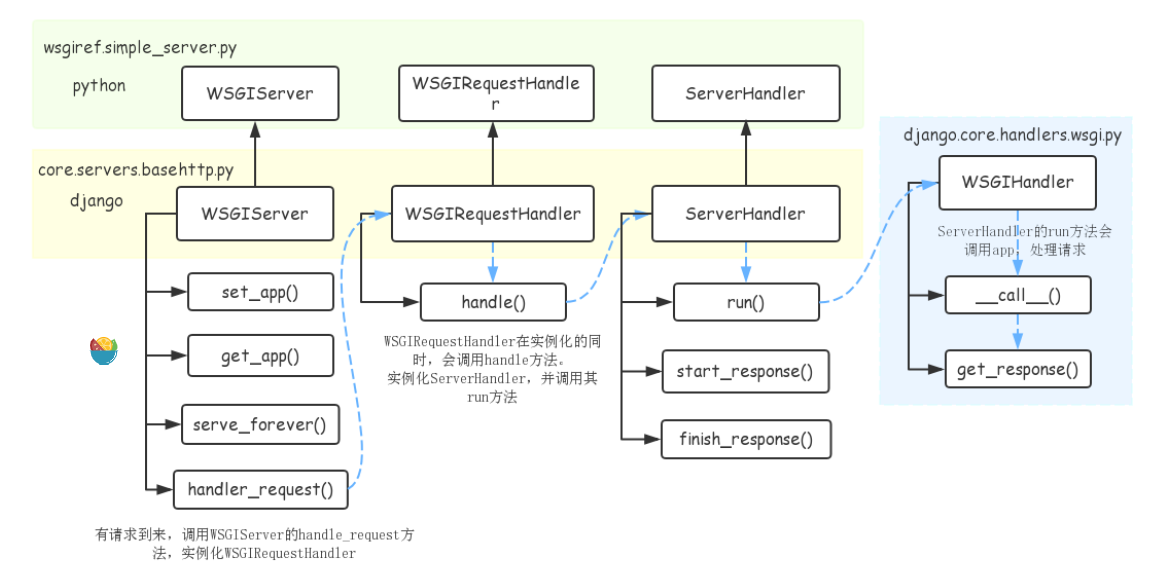python在web开发中一定见过WSGI、uWSGI、uwsgi这些。django和flask、trando这些框架都是运行在WSGI协议之上的。
django、flask、tronado这些框架运行起来本身就能提供服务访问,那么为什么部署还会另外使用到nginx或者是appache这些服务器呢。
 上图中左边是一些服务器,右边是常见的一些框架,中间只有一个WSGI。就上图展开聊一聊WSGI,uWSGI,和服务器、WSGI、框架之间的联系。
上图中左边是一些服务器,右边是常见的一些框架,中间只有一个WSGI。就上图展开聊一聊WSGI,uWSGI,和服务器、WSGI、框架之间的联系。
WSGI
WSGI是一种规范协议,全称Web Server Gateway Interface。不是服务器,不是通讯协议,也不是框架,而是一种规范。用来描述web server和web application通信的规范。实现web框架server和application的解耦。
WSGI协议主要包含两个部分:
WSGI server:负责从客户端接收请求request,将请求转发给application,将application返回的请求响应结果response发送给客户端。WSGI server工作原理:从底层解析http解析,然后调用应用程序,给应用程序提供(环境信息)和(回调函数), 这个回调函数是用来将应用程序设置的http header和status等信息传递给服务器方.
WSGI application:接收由server转发的请求,经过服务端相应的处理最后得到的结果发送给WSGI server。结果包含header,body和status,以便返回给服务器方。
WSGI application:中可以包含多个中间件middleware这些中间件需要同时实现server与application,因此可以在WSGI服务器与WSGI应用之间起调节作用:对服务器来说,中间件扮演应用程序,对应用程序来说,中间件扮演服务器。
WSGI协议其实是定义了一种server与application解耦的规范,上图很形象的展示了WSGI将server和application联系起来,即可以有多个实现WSGI server的服务器,也可以有多个实现WSGI application的框架,那么就可以选择任意的server和application组合实现自己的web应用。例如uWSGI和Gunicorn都是实现了WSGI server协议的服务器,Django,Flask是实现了WSGI application协议的web框架,可以根据项目实际情况搭配使用。这些便是WSGI的优点。
uwsgi
与WSGI一样是一种通信协议,是uWSGI服务器的独占协议,用于定义传输信息的类型(type of information),每一个uwsgi packet前4byte为传输信息类型的描述,与WSGI协议是两种东西。
uWSGI
uWSGI是一个web服务器,实现了http ,uwsgi, WSGI等协议。
WSGI协议实现
以django为例,分析一下WSGI的实现过程。
django WSGI application
WSGI application应该实现为一个可调用对象,例如函数、方法、类(包含call方法)。需要接收两个参数:一个字典,该字典可以包含了客户端请求的信息以及其他信息,可以认为是请求上下文,一般叫做environment(编码中多简写为environ、env)一个用于发送HTTP响应状态(HTTP status )、响应头(HTTP headers)的回调函数通过回调函数将响应状态和响应头返回给server,同时返回响应正文(response body),响应正文是可迭代的、并包含了多个字符串。下面是Django中application的具体实现部分:
1
2
3
4
5
6
7
8
9
10
11
12
13
14
15
16
17
18
19
20
21
22
23
24
25
26
27
28
29
30
31
32
33
34
35
36
37
38
39
40
41
class WSGIHandler(base.BaseHandler):
initLock = Lock()
request_class = WSGIRequest
def __call__(self, environ, start_response):
# 加载中间件
if self._request_middleware is None:
with self.initLock:
try:
# Check that middleware is still uninitialized.
if self._request_middleware is None:
self.load_middleware()
except:
# Unload whatever middleware we got
self._request_middleware = None
raise
set_script_prefix(get_script_name(environ))
# 请求处理之前发送信号
signals.request_started.send(sender=self.__class__, environ=environ)
try:
request = self.request_class(environ)
except UnicodeDecodeError:
logger.warning('Bad Request (UnicodeDecodeError)',
exc_info=sys.exc_info(),
extra={'status_code': 400,})
response = http.HttpResponseBadRequest()
else:
response = self.get_response(request)
response._handler_class = self.__class__
status = '%s %s' % (response.status_code, response.reason_phrase)
response_headers = [(str(k), str(v)) for k, v in response.items()]
for c in response.cookies.values():
response_headers.append((str('Set-Cookie'), str(c.output(header=''))))
# server提供的回调方法,将响应的header和status返回给server
start_response(force_str(status), response_headers)
if getattr(response, 'file_to_stream', None) is not None and environ.get('wsgi.file_wrapper'):
response = environ['wsgi.file_wrapper'](response.file_to_stream)
return response
可以看出application的流程包括:加载所有中间件,以及执行框架相关的操作,设置当前线程脚本前缀,发送请求开始信号;处理请求,调用get_response()方法处理当前请求,该方法的的主要逻辑是通过urlconf找到对应的view和callback,按顺序执行各种middleware和callback。调用由server传入的start_response()方法将响应header与status返回给server。返回响应正文
django WSGI Server
负责获取http请求,将请求传递给WSGI application,由application处理请求后返回response。以Django内建server为例看一下具体实现。
通过runserver运行django项目,在启动时都会调用下面的run方法,创建一个WSGIServer的实例,之后再调用其serve_forever()方法启动服务。
1
2
3
4
5
6
7
8
9
10
11
12
13
def run(addr, port, wsgi_handler, ipv6=False, threading=False):
server_address = (addr, port)
if threading:
httpd_cls = type(str('WSGIServer'), (socketserver.ThreadingMixIn, WSGIServer), {})
else:
httpd_cls = WSGIServer
# 这里的wsgi_handler就是WSGIApplication
httpd = httpd_cls(server_address, WSGIRequestHandler, ipv6=ipv6)
if threading:
httpd.daemon_threads = True
httpd.set_app(wsgi_handler)
httpd.serve_forever()
下面表示WSGI server服务器处理流程中关键的类和方法

WSGIServerr
run()方法会创建WSGIServer实例,主要作用是接收客户端请求,将请求传递给application,然后将application返回的response返回给客户端。
- 创建实例时会指定HTTP请求的
handler:WSGIRequestHandler类 - 通过
set_app和get_app方法设置和获取WSGIApplication实例wsgi_handler - 处理http请求时,调用
handler_request方法,会创建WSGIRequestHandler实例处理http请求。 WSGIServer中get_request方法通过socket接受请求数据。
WSGIRequestHandler
- 由
WSGIServer在调用handle_request时创建实例,传入request、cient_address、WSGIServer三个参数,__init__方法在实例化同时还会调用自身的handle方法。 handle方法会创建ServerHandler实例,然后调用其run方法处理请求
ServerHandler
WSGIRequestHandler在其handle方法中调用run方法,传入self.server.get_app()参数,获取WSGIApplication,然后调用实例(__call__),获取response,其中会传入start_response回调,用来处理返回的header和status。- 通过application获取response以后,通过
finish_response返回response
WSGIHandler
WSGI协议中的application,接收两个参数,environ字典包含了客户端请求的信息以及其他信息,可以认为是请求上下文,start_response用于发送返回status和header的回调函数。
虽然上面一个WSGI server涉及到多个类实现以及相互引用,但其实原理还是调用WSGIHandler,传入请求参数以及回调方法start_response(),并将响应返回给客户端。
django simple_server
django的simple_server.py模块实现了一个简单的HTTP服务器,并给出了一个简单的demo,可以直接运行,运行结果会将请求中涉及到的环境变量在浏览器中展示出来。
其中包括上述描述的整个http请求的所有组件:ServerHandler, WSGIServer, WSGIRequestHandler,以及demo_app表示的简易版的WSGIApplication。
可以看一下整个流程:
1
2
3
4
5
6
7
8
9
10
11
12
13
14
15
16
17
18
19
20
21
22
23
24
25
26
27
28
29
30
31
if __name__ == '__main__':
# 通过make_server方法创建WSGIServer实例
# 传入建议application,demo_app
httpd = make_server('', 8000, demo_app)
sa = httpd.socket.getsockname()
print("Serving HTTP on", sa[0], "port", sa[1], "...")
import webbrowser
webbrowser.open('http://localhost:8000/xyz?abc')
# 调用WSGIServer的handle_request方法处理http请求
httpd.handle_request() # serve one request, then exit
httpd.server_close()
def make_server(
host, port, app, server_class=WSGIServer, handler_class=WSGIRequestHandler
):
"""Create a new WSGI server listening on `host` and `port` for `app`"""
server = server_class((host, port), handler_class)
server.set_app(app)
return server
# demo_app可调用对象,接受请求输出结果def demo_app(environ,start_response):
from io import StringIO
stdout = StringIO()
print("Hello world!", file=stdout)
print(file=stdout)
h = sorted(environ.items())
for k,v in h:
print(k,'=',repr(v), file=stdout)
start_response("200 OK", [('Content-Type','text/plain; charset=utf-8')])
return [stdout.getvalue().encode("utf-8")]
demo_app()表示一个简单的WSGI application实现,通过make_server()方法创建一个WSGIServer实例,调用其handle_request()方法,该方法会调用demo_app()处理请求,并最终返回响应。
uWSGI
uWSGI旨在为部署分布式集群的网络应用开发一套完整的解决方案。主要面向web及其标准服务。由于其可扩展性,能够被无限制的扩展用来支持更多平台和语言。uWSGI是一个web服务器,实现了WSGI协议,uwsgi协议,http协议等。 uWSGI的主要特点是:
- 超快的性能
- 低内存占用
- 多app管理
- 详尽的日志功能(可以用来分析app的性能和瓶颈)
- 高度可定制(内存大小限制,服务一定次数后重启等)
uWSGI服务器自己实现了基于uwsgi协议的server部分,我们只需要在uwsgi的配置文件中指定application的地址,uWSGI就能直接和应用框架中的WSGI application通信。
参考文章
https://www.jianshu.com/p/679dee0a4193
https://www.letiantian.me/2015-09-10-understand-python-wsgi/
http://xiaorui.cc/archives/3209
